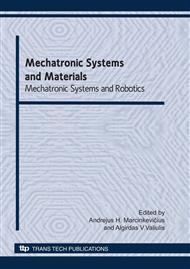p.377
p.383
p.387
p.392
p.405
p.411
p.419
p.425
p.431
Research of Hexapod Robot Motion in Irregular Terrain
Abstract:
This paper presents two inverse kinematics methods for position calculation of one leg hexapod robot. Further it is explained how inverse kinematics method could be applied to calculate robot body position. A trajectory repetition precision experiment was conducted for evaluation of dependence between trajectory repetition and a number of points used to describe it.
Info:
Periodical:
Pages:
431-434
Citation:
Online since:
June 2010
Authors:
Keywords:
Price:
Сopyright:
© 2010 Trans Tech Publications Ltd. All Rights Reserved
Share:
Citation:


